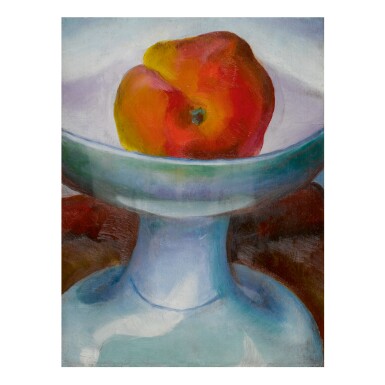Alfred Stieglitz, Georgia O’Keeffe, Juan Hamilton: Passage
Alfred Stieglitz, Georgia O’Keeffe, Juan Hamilton: Passage

GEORGIA O'KEEFFE | UNTITLED (APPLE AND WHITE DISH)
Auction Closed
March 5, 05:19 PM GMT
Estimate
200,000 - 300,000 USD
Lot Details
Description
GEORGIA O'KEEFFE
1887 - 1986
UNTITLED (APPLE AND WHITE DISH)
oil on panel
8 ⅛ by 6 ¼ inches
(20.6 by 15.9 cm)
Painted circa 1920.
The artist
Margaret Prosser, Lake George, New York, 1920s (gift from the above)
Private collection (by descent)
The artist, 1970s (acquired from the above)
Gift to the present owner from the above, 1983
Barbara Buhler Lynes, Georgia O'Keeffe: Catalogue Raisonné, vol. I, New Haven, Connecticut, 1999, no. 329, p. 178, illustrated
Carolyn Burke, Foursome: Alfred Stieglitz, Georgia O'Keeffe, Paul Strand, Rebecca Salsbury, New York, 2019, p. 103
While Paul Strand’s abstract ‘straight photography’ inspired Georgia O’Keeffe’s still life paintings, her study of famous Modern painters also shaped her approach to the subject in the early 1920s. Paramount among them, Paul Cézanne, whom Alfred Stieglitz revered as a genius among the Post-Impressionist painters. Stieglitz reproduced Cézanne’s paintings in the June 1913 issue of Camera Work, alongside extensive writings about his supreme influence on Modern painting, an endorsement similar to the praise Stieglitz bestowed upon O’Keeffe during this formative period in her career.
O’Keeffe’s early work in still life is best be examined alongside Cézanne’s accomplished body of work of the same subject, their similarities with regard to artistic process were recorded by Jonathan Stuhlman who observed, “Her early self-imposed restraint to work in only charcoal [...] echoes Cézanne’s dictum that one had to be the master ‘of one’s means of expression” (Ibid., p. 25). The present work Untitled (Apple and White Dish) recalls a similar color palette and the careful construction of Cézanne’s vibrant still life paintings though now reworked in O’Keeffe’s developing compositional structure that portrayed her subjects more intimately. The apple at center of the composition is surely symbolic of autumn in Lake George where both the artist and Stieglitz split their time in 1920 when the work was believed to be painted.
On the reverse of the present work is a landscape composition painted by Alfred Stieglitz’s father, Edward, and is signed by the elder Stieglitz at lower right. By 1920 O’Keeffe had now been living with Stieglitz in New York and this recycled board that O’Keeffe repurposed to paint Untitled (Apple and White Dish) was likely a family possession of Stieglitz’s that lingered in their home.
